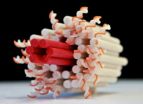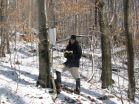(Press-News.org) As reported in the journal Science, physicists at the Technische Universitaet Muenchen (TUM) and the University of Michigan have shown that synthetic membrane channels can be constructed through "DNA nanotechnology." This technique employs DNA molecules as programmable building materials for custom-designed, self-assembling, nanometer-scale structures. The researchers present evidence that their nature-inspired nanostructures may also behave like biological ion channels. Their results could mark a step toward applications of synthetic membrane channels as molecular sensors, antimicrobial agents, and drivers of novel nanodevices.
Over the past three decades, researchers have advanced DNA nanotechnology from an intriguing idea to an emerging technology, with a toolbox of methods and a portfolio of nanometer-scale objects designed to demonstrate its potential. What's new here is the claim that DNA nanotech can be used to mimic one of the most widespread and important nanomachines in nature.
To wall off the insides of cells from the outside world, organisms in all three domains of life use the same kind of barrier: an impermeable membrane made from two layers of lipid molecules. Such membranes can also be found within cells, for example encapsulating the nucleus, and even surrounding many kinds of viruses. And to mediate between the different environments on either side of this universal barrier, nature provides a common type of passageway. Membrane channels are tube-like structures made of proteins, which pierce the barriers and regulate the two-way exchange of material and information between the inside and outside. Now researchers have demonstrated the first artificial membrane channel made entirely of DNA, and its characteristics suggest a number of potential applications. "If you want, for example, to inject something into a cell, you have to find a way to punch a hole into the cell membrane, and this device can do that, at least with model cell membranes," says TUM Prof. Hendrik Dietz, a fellow of the TUM Institute for Advanced Study.
In a shape inspired by a natural channel protein, the DNA-based membrane channel consists of a needle-like stem 42 nanometers long with an internal diameter of just two nanometers, partly sheathed by a barrel-shaped cap. A ring of cholesterol units around the edge of the cap helps the device "dock" to a lipid membrane while the stem sticks through it, forming a channel that appears to function like the real thing. TUM Professor Friedrich Simmel, co-coordinator of the Excellence Cluster Nanosystems Initiative Munich, explains: "We have not tested this yet with living cells, but experiments with lipid vesicles show that our synthetic device will bind to a bilayer lipid membrane in the right orientation, so that the stem both penetrates the membrane and holds at the surface, forming a pore."
Further experiments demonstrated that the resulting pores have electrical conductivity comparable to that of a natural cell wall with ion channels, suggesting that they might be able to act like voltage-controlled gates. The results also suggest that transmembrane current could be tuned by adjusting fine structural details of the synthetic channels. To test one potential application of the DNA nanotech devices, the researchers used them as "nanopores" for several different molecular sensing experiments. These confirmed that it is possible, by observing changes in the electrical characteristics, to record the passage of single molecules through synthetic membrane channels made from DNA. Because this approach allows both geometric and chemical tailoring of the membrane channels, it might offer advantages over two other families of molecular sensors, based on biological and solid-state nanopores respectively.
Other conceivable applications remain to be investigated. One notion is to imitate the action of viruses or phages, breaking through the cell walls of targeted bacteria to kill them. In gene therapy, synthetic membrane channels might be used as nano-needles to inject material into cells. Such channels could also be used in basic studies of cell metabolism. Another idea is to harness the so-called ion flux — which in cell membranes moves material in and out through the channel — to drive sophisticated nanodevices inspired by other natural mechanisms. "We might be able to mimic natural ion pumps, transport proteins, and rotary motors like the enzyme responsible for synthesizing ATP," says Dietz. "I love that idea. That's what keeps me running."
INFORMATION:
This work was supported by the German Research Foundation (DFG) via the TUM Institute for Advanced Study, Excellence Clusters NIM (Nanosystems Initiative Munich) and CIPSM (Center for Integrated Protein Science Munich), and SFB 863; by the Federal Ministry of Education and Research (BMBF, Grant 13N10970); by the European Research Council (Dietz, Starting Grant GA256270); and by the National Institutes of Health (Mayer, Grant 1R01GM081705).
Original publication:
Martin Langecker*, Vera Arnaut*, Thomas G. Martin*, Jonathan List, Stephan Renner, Michael Mayer, Hendrik Dietz°, and Friedrich C. Simmel°. Synthetic lipid membrane channels formed by designed DNA nanostructures. Science, vol. 338, issue 6109, pp. 932-936. DOI: 10.1126/science.1225624
(* equal contribution authors; ° co-corresponding authors)
Contact:
Prof. Hendrik Dietz
Technische Universitaet Muenchen
Physics Dept., Walter Schottky Institute / ZNN
Am Coulombwall 4a
85748 Garching, Germany
Tel: +49 89 289 11615
E-mail: dietz@tum.de
Web: http://bionano.physik.tu-muenchen.de/
Prof. Friedrich Simmel
Technische Universitaet Muenchen
Physics Dept., Walter Schottky Institute / ZNN
Am Coulombwall 4a
85748 Garching, Germany
Tel: +49 89 289 11611
E-mail: simmel@tum.de
Web: http://www.e14.ph.tum.de/
Technische Universitaet Muenchen (TUM) is one of Europe's leading universities. It has roughly 480 professors, 9000 academic and non-academic staff, and 31,000 students. It focuses on the engineering sciences, natural sciences, life sciences, medicine, and economic sciences. After winning numerous awards, it was selected as an "Excellence University" in 2006 and 2012 by the Science Council (Wissenschaftsrat) and the German Research Foundation (DFG). The university's global network includes an outpost with a research campus in Singapore. TUM is dedicated to the ideal of a top-level research-based entrepreneurial university. http://www.tum.de
Researchers build synthetic membrane channels out of DNA
Nanotech structures mimic nature's way of tunneling through cell walls
2012-11-20
ELSE PRESS RELEASES FROM THIS DATE:
Is Facebook a factor in psychotic symptoms?
2012-11-20
As Internet access becomes increasingly widespread, so do related psychopathologies such as Internet addiction and delusions related to the technology and to virtual relationships. Computer communications such as Facebook and chat groups are an important part of this story, says Dr. Uri Nitzan of Tel Aviv University's Sackler Faculty of Medicine and the Shalvata Mental Health Care Center in a new paper published in the Israel Journal of Psychiatry and Related Sciences.
In his study, the researcher presented three in-depth case studies linking psychotic episodes to Internet ...
How healthy are young people's lifestyles?
2012-11-20
This is the question asked by two of the articles in this week's issue of Deutsches Ärzteblatt International. Dieter Leyk from German Sport University Cologne (Deutsche Sporthochschule Köln) and coauthors investigated the effects of unhealthy lifestyles on young people's fitness, Sabine Stamm-Balderjahn from Berlin's Charité, and her coauthors report a study investigating the effects of a hospital-based intervention program to prevent smoking in school students (Dtsch Arztebl Int 2012; 109(44): 737-45 und Dtsch Arztebl Int 2012; 109(44): 746-52).
Leyk et al. collected ...
Researchers implicate well-known protein in fibrosis
2012-11-20
Chicago --- An international multi-disciplinary research team led by Northwestern Medicine scientists has uncovered a new role for the protein toll-like receptor 4 (TLR4) in the development of tissue fibrosis, or scarring.
This finding, recently reported in the American Journal of Pathology, has implications for the treatment of scleroderma, a condition for which there currently is no effective treatment.
TLR4 was previously implicated in inflammation, but its role in tissue fibrosis was unknown. Fibrosis is a hallmark of scleroderma and contributes to a range of common ...
Teens in arts report depressive symptoms, study says
2012-11-20
WASHINGTON – Teens who participate in after-school arts activities such as music, drama and painting are more likely to report feeling depressed or sad than students who are not involved in these programs, according to new research published by the American Psychological Association.
This is the first study to find that young people's casual involvement in the arts could be linked to depressive symptoms, according to the researchers. The article was published online in APA's journal Psychology of Aesthetics, Creativity, and the Arts.
"This is not to say that depression ...
Planck spots hot gas bridging galaxy cluster pair
2012-11-20
ESA's Planck space telescope has made the first conclusive detection of a bridge of hot gas connecting a pair of galaxy clusters across 10 million light-years of intergalactic space.
Planck's primary task is to capture the most ancient light of the cosmos, the Cosmic Microwave Background, or CMB. As this faint light traverses the Universe, it encounters different types of structure including galaxies and galaxy clusters – assemblies of hundreds to thousands of galaxies bound together by gravity.
If the CMB light interacts with the hot gas permeating these huge cosmic ...
Music to the ears for a good night's sleep?
2012-11-20
WINSTON-SALEM, N.C. – Nov. 20, 2012 – If you are among the 50 percent of Americans who suffer from insomnia, then you have probably tried everything – from warm milk to melatonin pills or prescription medications to induce sleep – with varying degrees of success and side effects. But what if sleep could be achieved not by a substance, but through 'balancing' brain activity?
Researchers at Wake Forest Baptist Medical Center have conducted a pilot clinical study to determine whether a non-invasive approach, that uses musical tones to balance brain activity, can 'reset' ...
Maple syrup, moose, and the local impacts of climate change
2012-11-20
Millbrook, N.Y. -- In the northern hardwood forest, climate change is poised to reduce the viability of the maple syrup industry, spread wildlife diseases and tree pests, and change timber resources. And, according to a new BioScience paper just released by twenty-one scientists, without long-term studies at the local scale—we will be ill-prepared to predict and manage these effects.
Following an exhaustive review of more than fifty years of long term data on environmental conditions at the Hubbard Brook Experimental Forest, located in the White Mountains of New Hampshire, ...
Timely change for tweeters' tune
2012-11-20
Do birds change their tune in response to urban noise? It depends on the bird species, according to Dr. Alejandro Ariel Ríos-Chelén from the Universidad Nacional Autónoma de México and colleagues. Their work shows that while some birds do adapt their songs in noisy conditions by means of frequency changes, others like the vermilion flycatchers adapt their song by means of changes in song lengths. The work is published online in Springer's journal, Behavioral Ecology and Sociobiology.
Birds use their songs during social interactions to attract females and repel intruders. ...
Huddersfield professor's ground-breaking research shows just how well the 2012 Games were run
2012-11-20
UNIQUE research conducted by a University of Huddersfield professor confirms just how successfully the 2012 Olympics and Paralympics were designed, organised and delivered. His findings will reveal to planners of the 2016 Games in Brazil just what they must do to meet or exceed the standards set by London.
Professor David Bamford, an expert in the theory of operations management and how it can be applied to the sports arena, was granted full access to the Paralympics village in London and with his team of researchers he quizzed hundreds of athletes, seeking their views ...
Robotic fish research swims into new ethorobotics waters
2012-11-20
NEW YORK, November 20, 2012 – Researchers at the Polytechnic Institute of New York University (NYU-Poly) have published findings that further illuminate the emerging field of ethorobotics — the study of bioinspired robots interacting with live animal counterparts.
Maurizio Porfiri, associate professor of mechanical and aerospace engineering at NYU-Poly, doctoral candidates Vladislav Kopman and Jeffrey Laut and research scholar Giovanni Polverino studied the role of real-time feedback in attracting or repelling live zebrafish in the presence of a robotic fish.
Their ...
LAST 30 PRESS RELEASES:
New expert guidance urges caution before surgery for patients with treatment-resistant constipation
Solar hydrogen can now be produced efficiently without the scarce metal platinum
Sleeping in on weekends may help boost teens’ mental health
Study: Teens use cellphones for an hour a day at school
After more than two years of war, Palestinian children are hungry, denied education and “like the living dead”
The untold story of life with Prader-Willi syndrome - according to the siblings who live it
How the parasite that ‘gave up sex’ found more hosts – and why its victory won’t last
When is it time to jump? The boiling frog problem of AI use in physics education
Twitter data reveals partisan divide in understanding why pollen season's getting worse
AI is quick but risky for updating old software
Revolutionizing biosecurity: new multi-omics framework to transform invasive species management
From ancient herb to modern medicine: new review unveils the multi-targeted healing potential of Borago officinalis
Building a global scientific community: Biological Diversity Journal announces dual recruitment of Editorial Board and Youth Editorial Board members
Microbes that break down antibiotics help protect ecosystems under drug pollution
Smart biochar that remembers pollutants offers a new way to clean water and recycle biomass
Rice genes matter more than domestication in shaping plant microbiomes
Ticking time bomb: Some farmers report as many as 70 tick encounters over a 6-month period
Turning garden and crop waste into plastics
Scientists discover ‘platypus galaxies’ in the early universe
Seeing thyroid cancer in a new light: when AI meets label-free imaging in the operating room
Neutrophil-to-lymphocyte ratio may aid risk stratification in depressive disorder
2026 Seismological Society of America Annual Meeting
AI-powered ECG analysis offers promising path for early detection of chronic obstructive pulmonary disease, says Mount Sinai researchers
GIMM uncovers flaws in lab-grown heart cells and paves the way for improved treatments
Cracking the evolutionary code of sleep
Medications could help the aging brain cope with surgery, memory impairment
Back pain linked to worse sleep years later in men over 65, according to study
CDC urges ‘shared decision-making’ on some childhood vaccines; many unclear about what that means
New research finds that an ‘equal treatment’ approach to economic opportunity advertising can backfire
Researchers create shape-shifting, self-navigating microparticles
[Press-News.org] Researchers build synthetic membrane channels out of DNANanotech structures mimic nature's way of tunneling through cell walls




